29.10.2017
Is there anybody out there?
The past, present and future of SETI, the search for extraterrestrial intelligence
About 2,000 years ago, just before the start of the Common Era, the Romans conquered Spain. The Roman Empire was powered by money, and the currency of the time was silver. Fortunately for the Romans, there were an ample number of silver mines in their new Spanish territory.
It takes a lot of energy to smelt silver into coins, so the Romans cut down vast swaths of Spain's forests to burn the wood for fuel. A byproduct of the smelting process is lead, which the Romans used for plumbing. For the first time, our species was engaged in large-scale industrial manufacturing—and also large-scale pollution. Signs of all this can be found in Greenland ice cores.
Pete Worden is the executive director of Breakthrough Initiatives, which funds efforts to search for life beyond Earth. He recently told me Roman silver mining is arguably the first time humans' impact on the planet was noticeable from outer space.
"If you were sitting at a nearby star and had the ability to take a spectrum of the atmosphere, with technology that we can imagine in the next few decades, you would detect these things that are at least, from our understanding, clearly industrial pollutants," he said.
A popular science fiction notion, as portrayed in the novel and movie Contact, by Planetary Society co-founder Carl Sagan, is that intelligent life might pick up our stray TV transmissions. But that's not possible with Earthling-level technology. If aliens in orbit around Proxima Centauri, our nearest stellar neighbor, broadcasted us episodes of I Love Lucy, we wouldn't hear them, unless they put a lot more power in their transmitters than ours.
We are, however, on the verge of being able to pick up missile detection radar-level signals. And if something as noisy as the Arecibo Observatory planetary radar in Puerto Rico, which is used to zap near-Earth asteroids, was aimed in our direction, we'd definitely hear—assuming we were listening and pointing in the right direction.
But in the end, it might not be our radio traffic that gives us away. Intelligent beings might already know we're here, thanks to the way we've tinkered with our planet's ecosystem.
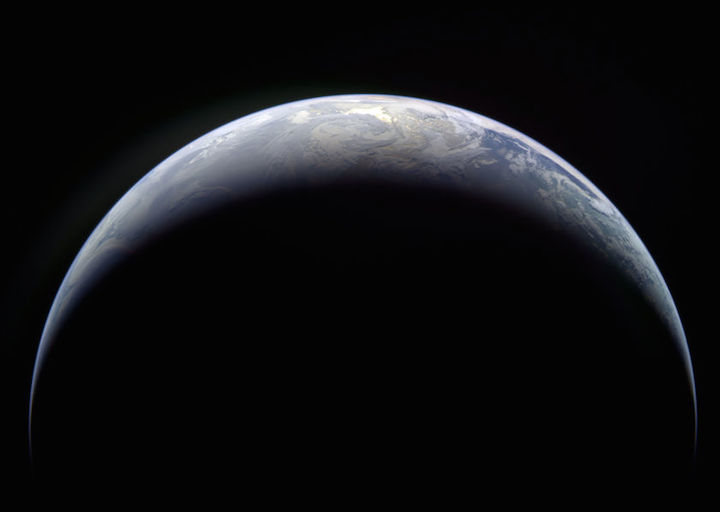
ESA / OSIRIS Team MPS / UPD / LAM / IAA / RSSD / INTA / UPM / DASP / IDA / Gordan Ugarković
CRESCENT EARTH FROM ROSETTA
Rosetta viewed Earth in a thin crescent phase as it approached for its November 13, 2009 flyby.The question of whether or not we are alone in the universe lies at the heart of many reasons we explore space. But for more than half a century, one branch of science has tried to answer the question more directly. SETI, the search for extraterrestrial intelligence, started as a fringe science, surged to a taxpayer-funded endeavor and receded into a privately funded effort.
The field's history involves semi-secret meetings, blustering congressional representatives and unexplained signal detections. Now, a surge of cash has given SETI new life. New arrays of powerful radio telescopes rising in South Africa and Australia could help revolutionize the field. Meanwhile, other upcoming projects promise to realize the dream of watching the entire sky for signals, all of the time.
Is there anybody out there? We may be closer to the answer today than ever before.
When you're finished with the story, don't miss our special episode of Planetary Radio with Breakthrough Initiatives executive director Pete Worden!
Part I: SETI then
The story of modern SETI begins in 1959, when Cornell University scientists Giuseppe Cocconi and Philip Morrison published a paper in Nature titled "Searching for Interstellar Communications." The paper opens with a simple assumption: If intelligent beings know we're here, they might try to get in touch. This premise remains one of the bedrocks of the field.
What sort of beacon would extraterrestrials use? The electromagnetic spectrum is large, ranging from low-frequency radio waves to high-frequency gamma rays. Fortunately, there's a practical limitation that narrows the possibilities: Earth's atmosphere blocks large portions of the spectrum. Cocconi and Morrison reasoned an advanced civilization would recognize our limitations and transmit something we could detect on the ground.
Furthermore, since high-frequency wavelengths require more transmitting power, Cocconi and Morrison believed a good place to search would be in the radio and microwave spectrum, between 1 and 10,000 megahertz. From FM radio to X-band spacecraft communications, this is indeed where we humans do most of our over-the-air communications.
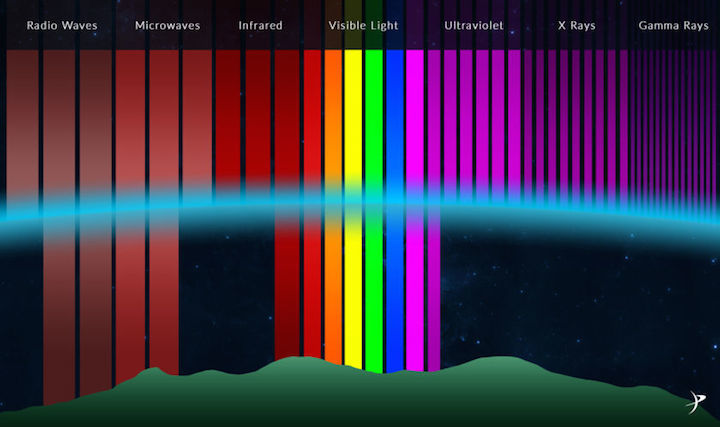
The Planetary Society
THE ATMOSPHERE'S EFFECT ON ELECTROMAGNETIC RADIATION
Earth's atmosphere prevents large chunks of the electromagnetic spectrum from reaching the ground, providing a natural limit on where ground-based observatories can search for SETI signals.Modern, digitally equipped radio telescopes can listen to large swaths of the spectrum simultaneously. But early on, analog receivers were limited to small slices at a time. To narrow the search further, Cocconi and Morrison turned to the universal language of science. Hydrogen, the lightest and most abundant chemical element in the cosmos, emits photons at frequencies of 1,420 megahertz. Later, a cluster of hydroxyl photon emission frequencies around 1,660 megahertz were proposed. When hydrogen and hydroxyl combine, they form H2O—water. Since life as we know it requires water, the region between these two frequencies became known as the water hole, a proverbial place for galactic citizens to meet in the desert of space. It was a frequent target of early SETI scans, and most modern searches still include it.
The same year Cocconi and Morrison published their landmark paper, Frank Drake, a staff astronomer at the National Radio Astronomy Observatory in Green Bank, West Virginia, independently prepared to conduct the first SETI search using the institution's new 26-meter Tatel radio telescope. The search was dubbed Project Ozma, after a fictional princess from the Land of Oz, and started scanning the water hole for signals from nearby stars Tau Ceti and Epsilon Eridani in 1960.
One year later, the National Academy of Sciences hosted an invitation-only meeting at Green Bank to discuss how to go about conducting further SETI research. The eclectic, interdisciplinary group included Drake, Cocconi, Morrison, the biochemist Melvin Calvin (who won the Nobel Prize in Chemistry during the meeting), Bernard Oliver, who was the vice president of research and development at Hewlett-Packard, the young Carl Sagan, and the scientist John Lilly, who had recently published a controversial book arguing dolphins were an intelligent species.
With a nod to Lilly's book, the participants dubbed themselves "The Order of the Dolphin." One product of the meeting was the Drake equation, which attempts to predict the number of advanced civilizations in the Milky Way able to contact Earth. The equation includes variables such as average star formation rate, the number of habitable planets per star, and the number of planets where intelligent life could evolve.
After 200 hours of observing, Project Ozma came up empty. But the field of SETI was officially born.
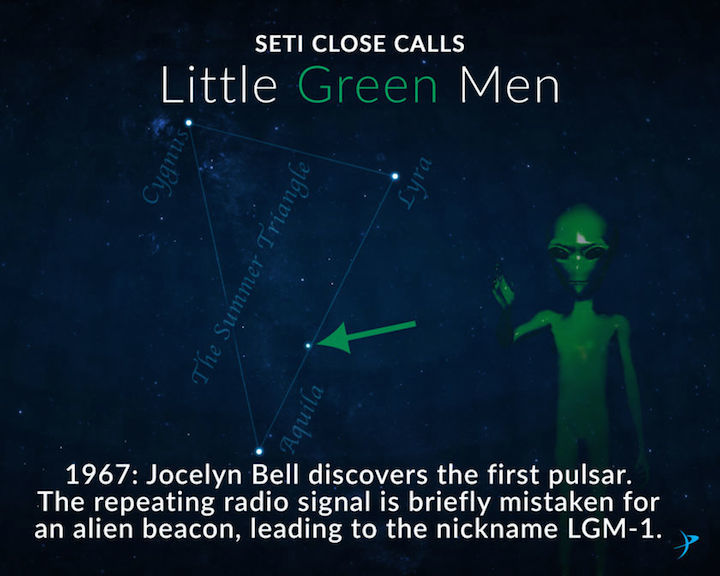
SETI CLOSE CALLS: LGM-1
Wow!
For the rest of the 1960s, SETI research remained mostly dormant, aside from a few searches in the Soviet Union. Starting in 1971, two Project Ozma follow-ups named Ozpa and Ozma II used bigger dishes and listened to more stars.
In 1973, another SETI search began, using a radio telescope called Big Ear at Ohio State University. Big Ear was a flat, aluminum dish three football fields wide, with reflectors at both ends.
On the night of August 15, 1977, Big Ear picked up a signal from the constellation Sagittarius that was 30 times stronger than the cosmic background noise, right at the 1,420 megahertz hydrogen line frequency. No one noticed it for a few days, until a volunteer sifting through the previous week's data circled the signal and wrote "Wow!" in the margin.
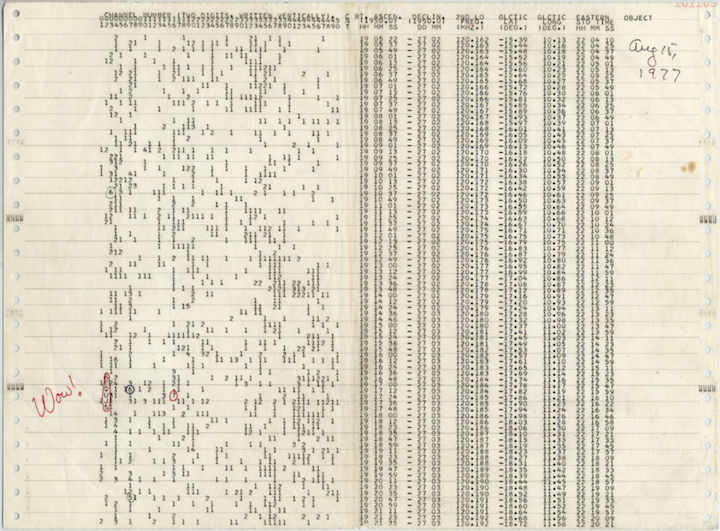
Courtesy of the Ohio History Connection
THE WOW! SIGNAL
On the night of August 15, 1977, Ohio State's Big Ear radio telescope picked up a signal from the constellation Sagittarius that was 30 times stronger than the cosmic background noise.Jill Tarter is a legendary SETI scientist. She's the Bernard Oliver Chair for SETI at the SETI Institute in Mountain View, California, and is the inspiration for protagonist Ellie Arroway in Contact, played by Jodie Foster in the film adaptation.
Tarter told me Big Ear's automated search program had no built-in logic to stop and focus on the Wow! signal. Furthermore, there was no confirmation system such as a second telescope located elsewhere, which could help determine whether the signal was local to Earth or truly from the stars.
Despite decades of follow-up searches, the Wow! signal was never heard again. To this day, Tarter favors SETI programs that can process data in real time, rapidly follow-up on detections, and rule out local interference.
I asked her if the Wow! signal still haunts the SETI field. "Well, it haunts me," she said.
NASA gets involved
By the end of the 1970s, NASA got involved, giving the field a huge boost in credibility. The agency planned to conduct SETI research on two fronts. A systematic, all-sky search would be led by NASA's Jet Propulsion Laboratory, primarily using the agency's Deep Space Network facilities. JPL director Bruce Murray, who co-founded The Planetary Society in 1980, was a strong proponent of this approach.
At the same time, NASA's Ames Research Center would examine nearby stars similar to our Sun, using Arecibo, Green Bank, Parkes Observatory in Australia, and Nancay Observatory in France. Both JPL and Ames would look at frequencies between 1,000 and 3,000 megahertz, covering a large swath of the spectrum near the water hole.
But before the search began, it was met with political resistance. In 1979, Senator William Proxmire bestowed his ignominious "Golden Fleece Award" on the program, calling it a waste of taxpayer dollars. Three years later, Proxmire got SETI funding on the chopping block. Carl Sagan personally met with the senator to convince him SETI was a worthwhile endeavor, arguing it would spur development of advanced technologies and potentially offer evidence Earthlings can survive what Sagan dubbed our "technological adolescence," should we make contact with other beings. A petition signed by leading world scientists and Nobel laureates bolstered Sagan's argument.
At the time, the program had strong support from the scientific community, said Andrew Siemion, the director of the SETI Research Center at the University of California, Berkeley.
"Looking back at some of the study conferences that were held, before the first time Congress tried to kill the funding, it's just absolutely incredible," he said. "I mean, it's virtually a who's-who of not just astronomy, but of science and technology."
Proxmire backed down, and following another decade of development, NASA's SETI program officially went online in 1992, innocuously re-branded as the High Resolution Microwave Survey.
The SETI Institute
NASA contracted much of its SETI activities to the SETI Institute, a nonprofit formed in 1984. A group of SETI researchers, including John Billingham, who spearheaded some of NASA's initial SETI efforts at Ames, grew irked that the academic researchers NASA hired came with high overhead costs, in the form of extra percentages paid to researchers' universities. In the case of Stanford University, Tarter said, the overhead rate was 100 percent—meaning every dollar paid for a researcher's time required another dollar paid to Stanford.
Billingham had an idea: What if an independent institution could hire the researchers directly, charge less, and then apply for the same grants?
"Our whole motive was to save NASA money," said Tarter, who became the SETI Institute's first employee. "We could actually set our own overhead rate at the true cost of doing business. As opposed to 100 percent, it was more like 20 percent." The cost savings were funneled into building hardware for SETI searches.
But the NASA-led search was barely underway when it came under fire again. This time, Nevada Senator Richard Bryan attacked the program. Once more, Sagan and others prepared to lobby on NASA's behalf, but Bryan outright refused to meet with anyone involved with SETI. In 1993, after a total investment of $60 million and just one year of operations, the High Resolution Microwave Survey was canceled.
"This hopefully will be the end of Martian hunting season at the taxpayer's expense," said a press release from Bryan.
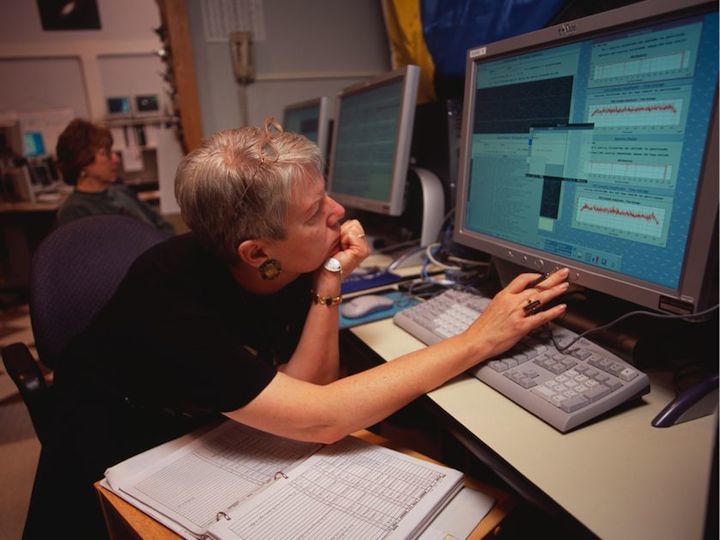
Louis Psihoyos / Courtesy of Jill Tarter
JILL TARTER AT ARECIBO OBSERVATORY
The SETI Institute scrambled to pick up the pieces. Fortunately, said Tarter, the proposals for observing time at Arecibo and Parkes had already been peer-reviewed and accepted.
"I then wrote to all of the (observatories) on which we had been granted time and said, 'If we can come up with the money to keep this project going, can we still have the time?' They all responded yes," she said.
The Ames portion of the SETI program rose from the ashes as Project Phoenix, a suite of equipment that could be connected to large radio dishes like Arecibo, Parkes, and Green Bank. From 1995 through 2004, Project Phoenix scanned Sun-like stars at a frequency between 1,000 and 3,000 megahertz.
The JPL all-sky search using NASA's Deep Space Network, however, could not be salvaged. A final attempt to install SETI equipment at NASA's Deep Space Network facility in Goldstone, California, which would passively collect data from wherever the telescope aimed, was swiftly rejected.
"NASA came back and said, 'Oh no you won't.' They really shut it down hard," said Tarter. "Bryan had done this with such vengeance that we became the four-letter-S-word you couldn't say at NASA headquarters."
The Planetary Society
In 1978, during one of his many appearances on The Tonight Show, Planetary Society co-founder Carl Sagan discussed SETI at length with host Johnny Carson. In a pre-Internet era where most Americans only had a few channels, Sagan and Carson spent 15 minutes on prime-time television discussing everything from Star Wars ("I felt very bad that, at the end, the Wookiee didn't get a medal," Sagan said) to how aliens might send us a signal using prime numbers.
"The remarkable thing is, for all the history of mankind, people have wondered about intelligence elsewhere—I think it's in religion and philosophy, legends—but this is the first time that we have the competence and ability to actually do such a search, and we are just beginning," Sagan said.
The Planetary Society's involvement in SETI practically began when the organization was founded in 1980. Just one year later, NASA and the Society funded Suitcase SETI, a portable spectrum analyzer that could be installed on large radio telescopes like Arecibo. Suitcase SETI eventually grew into Sentinel, an all-sky search using a 26-meter radio telescope at Harvard University. Next came META, the Megachannel ExtraTerrestrial Assay, funded with a significant donation from Steven Spielberg, who was then a Planetary Society board member.
These projects were led by Paul Horowitz, a Harvard physicist and electrical engineer. Horowitz said META was able to pick through 8 million slices of radio frequency at a time, making it the most advanced SETI search ever when it came online in 1985. Yet when compared to modern processing capabilities, its performance was paltry.
"I had that thing (the META computer) in a double rack, and at the top, it said, 'META supercomputer—75 million instructions per second,'" Horowitz said. "Now, your cell phone is better than that."
During a decade of operations, META found 37 "candidate events"—strong signals of unknown origin. None have ever repeated. The Society launched a southern hemisphere clone of the project named META II, and META eventually evolved into BETA, which increased the processing capacity of the Harvard telescope to a quarter-billion channels at once, scanning the water hole between 1,400 and 1,700 megahertz. BETA operated until 1999, when a storm damaged the antenna's drive gear.
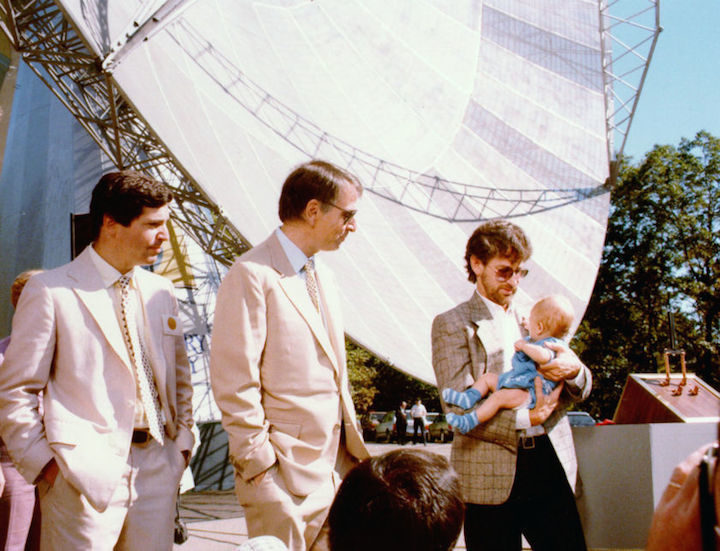
The Planetary Society
FLIPPING THE SWITCH
Paul Horowitz, Carl Sagan and Steven Spielberg (holding his son, Max) activate The Planetary Society’s META project in 1985.Around the same time, Horowitz's group, motivated by Charles Townes, who invented the laser, started tinkering with optical SETI searches. Visible light has a higher frequency than radio waves, allowing more data to be encoded over any given period of time. Like radio waves, visible light also filters through our atmosphere, making it a logical portion of the spectrum for SETI searches.
In 2006, Horowitz and The Planetary Society constructed a 1.8-meter telescope at Harvard which began the first dedicated, all-sky optical SETI survey. The search is still in operation, completing a full survey of the sky visible from Massachusetts every 200 nights.
Meanwhile, in the late 1980s, The Planetary Society, NASA and the National Science Foundation helped fund a west coast SETI effort called SERENDIP at the University of California, Berkeley. SERENDIP, as its name implies, looks for serendipitous SETI detections by piggybacking on traditional astronomical observations made by large radio telescopes. The program has undergone many upgrades and relocations over the years, and was still running at Arecibo when the telescope was damaged by Hurricane Maria in September 2017.
SERENDIP originally processed data in real-time, but Berkeley soon began archiving the data and sifting through them using computer algorithms. There were more data available than could be processed using supercomputers, said Dan Werthimer, who is now chief scientist of the Berkeley SETI Research Center. Werthimer and three other engineers and scientists designed a program to allow home computers to help with the data crunching.
"We had this wild and crazy idea to use volunteers to analyze our data, but we took it around to various people, and nobody seemed to think it would ever work," Werthimer told me. "The Planetary Society said, 'Hey this wild, crazy idea? We want to get behind it.' And they gave us the money to launch the project."
In 1999, Berkeley released the result, SETI@home, and since then more than 8 million people have downloaded the program and donated spare computing power to help search for intelligent life. The open-source software, BOINC, on which SETI@home is based, is now used for other projects. This led to what Werthimer calls "the democratization of supercomputing," where users can choose individual research programs to assist.
Andrew Siemion, the Berkeley SETI Research Center director, credits The Planetary Society's SETI@home involvement for helping keep the field alive prior to his arrival at Berkeley as a student in 2004.
"Science is about standing on the shoulders of giants," he said. "Frankly, we would not be here today were it not for the support specifically of the Planetary Society."
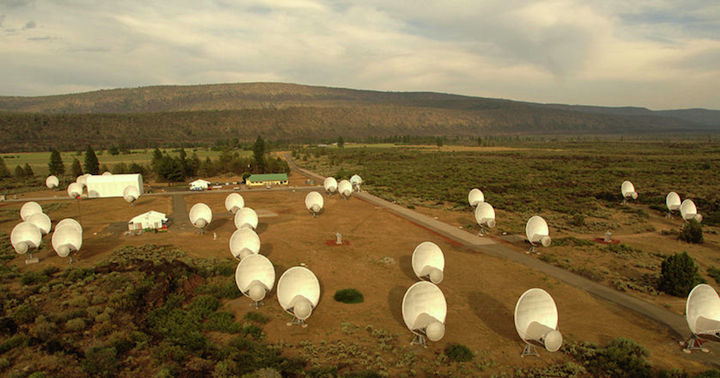
Seth Shostak / The SETI Institute
THE ALLEN TELESCOPE ARRAY
The Allen Telescope Array
Before the SETI Institute's resurrected NASA program, Project Phoenix, came to a close in 2004, the group planned for what would come next.
A series of workshops involving scientists, engineers and Silicon Valley computing experts concluded the next step in SETI radio research should be a large array of small telescopes. Signals from small dishes can be combined, ultimately covering larger swaths of the sky than single, large dishes, and smaller dishes are cheaper, often using off-the-shelf hardware.
In 2007, the Allen Telescope Array, named after its benefactor, Microsoft co-founder Paul Allen, went online at Hat Creek Observatory in northern California. Using digital technology to process incoming signals, the array was built with long-term scalability in mind. Early on, it collected more data than could be processed. Now, there is a near-match between data volume and processing power, and by the end of the project, SETI scientists should be data-starved.
The original design called for 350 dishes. But the antennas cost more than predicted, and Berkeley, originally a project partner, could not secure hoped-for operating funds from the National Science Foundation. The project was downsized, and taking a page from the Hitchhiker's Guide to the Galaxy, the SETI Institute stopped construction at 42.
"What number are you going to pick if you can't get to 350, right?" said Tarter.
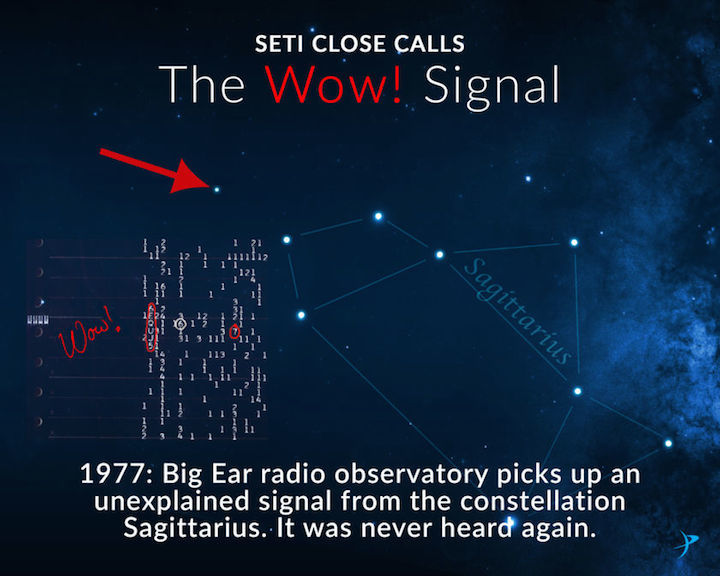
The Planetary Society
SETI CLOSE CALLS: THE WOW! SIGNAL
Part II: SETI now
Shortly before 2000, Shelley Wright was working on her physics bachelor's degree at the University of California, Santa Cruz. One day, she saw a flyer for an astrobiology conference at NASA's Ames Research Center, and decided to attend.
During lunch at the conference, she unknowingly sat next to SETI experts Frank Drake and Dan Werthimer. She struck up a conversation, grew interested in the field, and ended up with a gig at Lick Observatory near San Jose, California, where she built an optical SETI detector as part of her undergraduate thesis. Drake became one of her advisors.
Many SETI scientists start in subjects like astronomy, astrophysics or engineering, and either work in related areas or find homes at places like the SETI Institute. Wright is now an assistant professor of physics at the University of California, San Diego, where she designs and builds telescope instruments used to study galaxies and black holes.
She also uses her talents for SETI research. Earlier in her career, she did so quietly, "because it was semi-taboo," she told me.
"The truth is, I think people want to work on SETI," Wright said. "It's just that we all have to pay rent. People need a career path, and if there is no government funding for this, it's really challenging."
Among those who do work on SETI, there are generation gaps corresponding to the field's ups and downs. First came the pioneers, like Drake. A second generation is represented by Tarter, Horowitz and Werthimer. The latest group includes Wright and Siemion, but both are quickly becoming mid-career scientists. A fourth generation needs training.
"There aren't a lot of graduate students that work on it," said Siemion. "This is a huge problem, obviously, for the field to kind of keep it going."
Generational gaps occur in other scientific fields, too, Werthimer said. "But SETI is a little more fragile."
In 2009, NASA launched the Kepler space telescope to hunt for planets around other stars, known as exoplanets. Before Kepler, only a handful of exoplanets were confirmed to exist; that number has now jumped to more than 3,500, with more than 2,000 confirmed by Kepler alone. Another 4,500 await independent confirmation. So far, scientists have found around 30 Earth-sized exoplanets in their stars' habitable zones, where liquid water could exist.
Kepler made the notion of intelligent beings on other worlds far less abstract. A SETI revolution was ready to happen; the field just needed a financial breakthrough.
The breakthrough
In 2012, a Russian billionaire named Yuri Milner announced a new annual award called the Breakthrough Prize, designed to hand out cash to scientists making major contributions to fundamental physics.
Milner, who is named after Yuri Gagarin, the first human to fly in space, was born in Moscow and initially studied physics before becoming a successful technology entrepreneur. In its 2017 iteration, the Breakthrough Prize awarded more than $25 million. It is the largest individual monetary science prize, and has expanded to include life sciences and mathematics.
By 2015, Pete Worden, then director of NASA Ames, heard Milner was interested in expanding his philanthropy to bolster the search for life. Under an umbrella group named Breakthrough Initiatives, Milner's benefaction would be split between SETI observations, characterizing nearby exoplanets, and developing a fleet of miniature, laser-powered sail spacecraft to visit the neighboring Alpha Centauri star system.
As a NASA center director, a lot of Worden's day-to-day work focused on "budget and personnel, and, you know, that the toilets don't work in building 18," he told me. He was happiest when he had time to arm himself with snacks, escape his office and visit scientists and engineers working on missions like Kepler.
When Worden found out about Milner's desire to seek answers to fundamental questions about life in the cosmos, he was intrigued. "Probably since I was a teenager—maybe even younger—I've had these questions on my mind," he said. "And they were clearly on Yuri Milner's mind, and he felt that now was the time to begin a set of initiatives to address those questions."
Worden retired from NASA that same year, and became the executive director of Breakthrough Initiatives. "I'm spending most of my time now on these big questions, which is really cool. I can't believe I'm so lucky," he said.
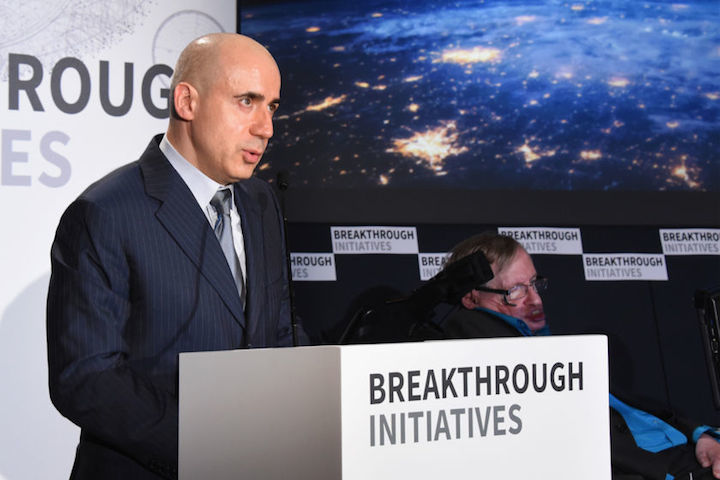
Stuart C. Wilson / Getty Images / Breakthrough Initiatives
YURI MILNER
Yuri Milner, flanked by Stephen Hawking, announces the Breakthrough Listen initiative in 2015.Money dilemma
A large cash influx could drastically alter the SETI landscape. The field's two biggest players were the SETI Institute and the SETI Research Center at Berkeley. At the time, representatives from both groups were working together on an initiative called FIRSST, which sought to create a long-term endowment for SETI research.
"If you don't have institutional funding—and apparently we're not going to be able to get that for SETI—then you need something like an endowment, so that people can take risks and do new things that don't necessarily provide publication next month," said Tarter, who was a FIRSST institutional liaison.
Milner ultimately funneled the funding through Berkeley, under a new program called Breakthrough Listen. Breakthrough would use the giant telescopes at Green Bank and Parkes to scan the nearest 1 million stars—a sphere about 1,000 light years across, covering the round-trip distance where other beings may have noticed our 2,000-year-old pollution habits and tried to get in touch. The program would also scan the Milky Way's galactic plane and the nearest 100 galaxies, while another telescope, the Automated Planet Finder at Lick Observatory, would conduct optical SETI searches.
Berkeley engineers set to work upgrading the digital processing capabilities at Green Bank and Parkes. The university's SETI Research Center would process the data, eventually making some of it available for SETI@home users.
Milner allocated $100 million to Breakthrough Listen, to be spent over a 10-year period. Worden said the annual spending rate varies; most recently it was between 6 and 7 million. The FIRSST endowment fizzled, and three SETI Institute representatives, including Tarter, joined the Breakthrough Listen advisory committee. But thus far, no Breakthrough funds have gone to the SETI Institute, or the Allen Array.
"We may just now be finding a way to work gracefully in concert with them," Tarter said. "It's been very disappointing for us, that we were essentially excluded."
A reciprocal arrangement
For the radio observatories participating in the search, Breakthrough Listen was a welcome new funding source.
In 2013, the National Science Foundation announced it would divest the Green Bank Telescope, forcing the observatory to start funding itself. The process was completed in 2016. In Australia, Parkes faces a similar, uncertain future. Parkes declined to say how much money the observatory has received from Breakthrough Listen thus far, while Green Bank did not respond to interview requests. But the funding was clearly welcome; Breakthrough is now paying to use a quarter of both telescopes' time. In 2015, Karen O'Neil, who is now the director at Green Bank, told The Planetary Society the new money would "go a long way toward helping secure the long-term future of the facility."
Securing observing arrangements at both locations required contracts with the U.S. and Australian governments, but Worden said the process went remarkably smoothly.
"I worked for the government most of my career, and I never saw the government move so quickly," he said. "We signed an agreement within a few weeks for millions of dollars."
Dedicating a quarter of observing time at Green Bank and Parkes to SETI impacts other telescope users. But somewhat making up for that is a reciprocal arrangement between SETI and traditional radio astronomy. The equipment Breakthrough installs can be used by other observers. At both locations, Berkeley engineers spent about a year installing high-end graphical processing units—the same found in video game cards—to process incoming signals. Those processing units are now "the most powerful digital instruments the telescopes have, full stop," said Siemion.
The arrangement also works in reverse. Through a technology called multibeam receivers, Breakthrough plans to use surplus observing bandwidth during other observations to run SETI searches on nearby swaths of sky. And because Breakthrough openly publishes all its data, SETI observations can be used to make other scientific discoveries.
Jimi Green is a senior systems scientist at CSIRO, Australia's national science agency, which runs Parkes Observatory. When I spoke to him via Skype, he sat in an operations center in Sydney, next to an array of screens used to remotely control the telescope. Green said the Breakthrough search is contributing to the quest to understand a mysterious astronomical phenomenon called Fast Radio Bursts, or FRBs.
FRBs are short, high-energy bursts of radio waves believed to come from outside our galaxy. The first was discovered in 2007, by a student searching archival Parkes data for a different reason. Astronomers aren't sure what causes FRBs—they could be anything from colliding black holes to laser-driven sail spacecraft.
"There's a joke in the community that there are more theories for what they are than there are detections," Green said.
Because SETI searches encompass seemingly random locations across the sky, they uniquely contribute to the hunt for FRBs.
"We don't know enough about (FRBs) yet, like where they come from, what mechanisms generate them, and so on," said Green. "So just doing this sort-of blind searching—wherever (Breakthrough) is looking, we're running at the same time—is a great way to do it." In August, the Breakthrough team, working with a collaboration of international researchers, announced they had detected 15 new pulses from a known FRB at a higher frequency and wider bandwidth than ever before.
The broadest search thus far
In April, Breakthrough Listen published the data from 692 stars observed during initial Green Bank telescope observations, and described the results in an upcoming paper for The Astrophysical Journal. Berkeley scientists also published a corresponding list of 11 "significant events" where radio signals spiked above the cosmic background noise. None were believed to be signals from intelligent beings, but 692 is only a fraction of the million stars the project will survey.
Back at Hat Creek Observatory in northern California, the Allen Array continues its own SETI search. Until recently, the array was looking at Kepler exoplanet candidates, but since it is now clear most stars have planets, the array is scanning the nearest 20,000 stars, most of which are red dwarfs. To pay for operating costs, the array allocates half of its observing time to SRI International, which subcontracts telescope usage for various research and communications projects.
Together, Breakthrough and the SETI Institute are conducting the broadest-ever targeted SETI radio search. The telescopes roughly cover frequencies between 1,000 and 15,000 megahertz; NASA's original HRMS program, for comparison, only searched between 1,000 and 3,000 megahertz.
Bill Diamond, the CEO and president of the SETI Institute, said Breakthrough Listen has hardly made the Allen Array redundant. He sees the two efforts as complementary, and notes the Allen Array has its own unique capabilities, including the ability to process data in real time.
"That immediate analysis gives us the opportunity to verify and eliminate false positives," he said.
Tarter said she would still like to find a way to get the array up to 350 dishes, which would increase its sensitivity and allow it to see more of the sky at once.
"I'm not giving up on that one," she said. "That would be one hell of an instrument for both SETI and radio astronomy."
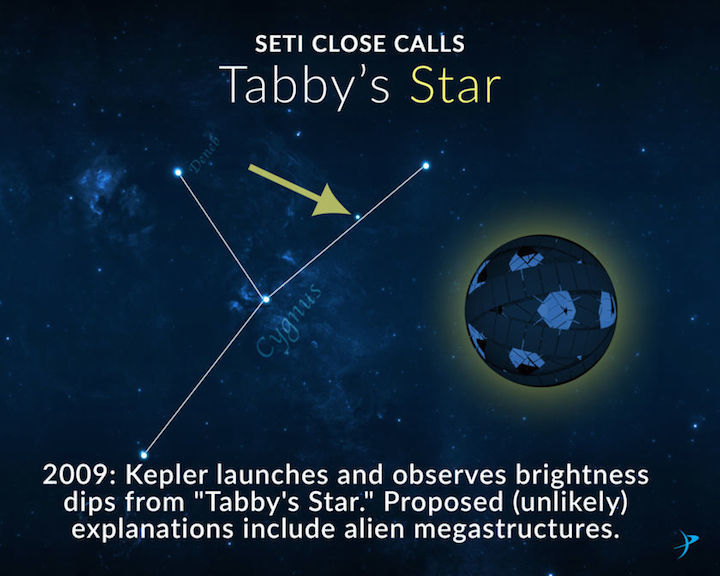
The Planetary Society
SETI CLOSE CALLS: TABBY'S STAR
Part III: SETI next
In a 1991 issue of The Planetary Report, Harvard's Paul Horowitz described a discussion he had with SETI pioneer Philip Morrison, and Michael Davis, then director of Arecibo Observatory. At Morrison's house, the trio talked about the future of SETI, theorizing about how to revolutionize the field. Horowitz put forth what he called "a favorite idea," that future radio searches would scrap large, traditional telescopes for massive arrays of small receivers listening to the entire sky all at once.
"There it is," he wrote. "A dry lake bed tiled with glistening purple checkerboards of silicon, quietly receiving radio signals from a multiplicity of directions."
I asked Horowitz if this 26-year-old idea was still feasible. He said it was, but that I shouldn't hold my breath for it to happen anytime soon.
"If someone wanted to put a billion dollars in it, we could probably build such a thing," he said. "It's not harder than getting to the Moon. It's just different."
At Parkes in Australia, Breakthrough Listen is currently surveying the Milky Way's galactic plane. During a single observation, the observatory's 64-meter telescope can listen to an area of sky about three Moons wide at a time. Surveying the galactic plane will take about 1,500 hours, and since Breakthrough only gets about one-fourth of the telescope's observing time, it will take a year to complete the survey. As a result, the telescope can only listen to each slice of sky for five minutes before moving on.
The Planetary Society's 1.8-meter optical SETI telescope at Harvard covers an even smaller area, just slightly larger than the Moon. Though the telescope is allocated entirely to SETI, it still has to fight cloudy Massachusetts nights and takes a year to complete one full sky survey. The total time spent staring at each patch of stars? Forty-eight seconds.
Herein lies the challenge of SETI: If intelligent beings are currently sending us a beacon, it would have to be near-continuous for us to receive it using our current methods.
"If we wanted to do the best possible experiment we could do, we would want to look at every wavelength, every frequency, all the time, in as many ways as we could possibly conceive of," said Andrew Siemion. "For now, we have to have to make choices."
PANO-SETI
Two new optical SETI projects are hoping to make giant leaps forward in our ability to watch the entire sky, all of the time. At the University of California, San Diego, Shelley Wright leads a team developing a system called PANO-SETI. Wright and other SETI experts, including Horowitz, recently spent a year brainstorming a way to continuously monitor the entire sky at once, which Wright calls "the ultimate optical solution."
A single telescope dish focuses and amplifies the light from one patch of sky at a time, creating sharp, high-resolution images of celestial objects. But using large telescopes for SETI is akin to searching the heavens through a soda straw. To watch the entire sky at once, you could build an array of giant telescopes, but that would be unthinkably expensive, and for optical SETI, you don't really need high-resolution images. Instead, you only need to count the number of photons coming through the telescope and see if that changes.
PANO-SETI relies on Fresnel lenses, named after their French inventor, who originally built them for lighthouses. A Fresnel lens takes a patch of sky and converts it into a single point, and a detector behind the lens called a solid state photomultiplier samples the light every nanosecond, watching for changes that could indicate the presence of a laser signal. The sample rate is faster than any known natural phenomenon, such as pulsars or the twinkling effect created by Earth's atmosphere.
Each hexagonal Fresnel lens is a half-meter across, and Wright's team envisions 126 of them mounted on the outside of an observatory dome just taller than a person. Like a fly's eye, the array would continuously sample the sky as it rotates overhead. Just a few of these 126-lens domes scattered around the world could continually monitor the entire celestial sphere.
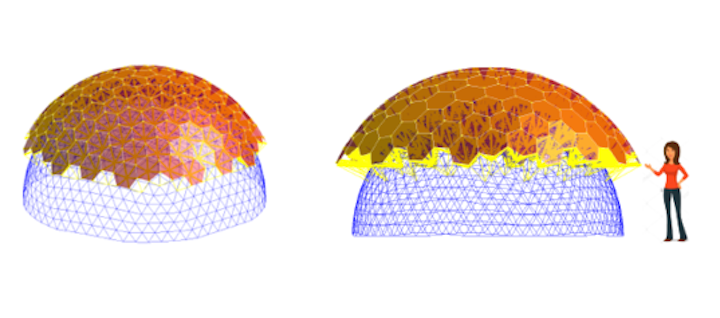
Wright et. al (2017)
TWO VIEWS OF A COMPLETED PANO-SETI DOME
PANO-SETI covers the entire visible spectrum, and as a bonus, a little bit of infrared. This is another area of Wright's expertise; in 2015, she commissioned NIROSETI, the first dedicated near-infrared SETI search. It successfully surveyed 1,000 stars, and Wright's team is preparing to publish the results. The idea of infrared SETI has been around for a long time, but it's expensive because the telescope instruments must be cooled to stop radiant heat from interfering with observations, and the detectors have traditionally been difficult to work with. Nevertheless, infrared is a logical place to search for signals; higher-energy visible wavelengths, like blues, scatter easily (this is why our sky is blue), making infrared a compelling choice for would-be extraterrestrial phone calls. (PANO-SETI will not require cooling because it does not dip deep enough into the infrared.)
Right now, Wright's team is testing a single Fresnel lens. They're almost ready to take it out for trial runs, and she also sees potential to use the technology in other fields.
"We're learning a ton of things, which I think are applicable to other applications in astronomy, and other science," she said.
PANO-SETI could detect the most powerful lasers we have on Earth from a distance out to a few thousand light-years. The team has enough funding for design and prototyping, but to make the concept a reality, they'll need additional investment. They pitched the idea to Breakthrough Listen, but have yet to get a response.
Laser SETI
Another advantage of all-sky surveys over targeted searches is that they also capture the void of space between stars and galaxies. If there's something unseen saying hello from the blackness, an all-sky search could pick it up.
Eliot Gillum is the director of the SETI Institute's optical SETI program, which recently introduced an all-sky solution called Laser SETI. Goal-wise, Laser SETI is similar to PANO-SETI; the former is less sensitive, but cheaper.
Laser SETI uses off-the-shelf, wide-field camera lenses to monitor the sky. A single observatory has eight cameras, housed in small, horn-shaped enclosures small enough to carry. The concept is relatively inexpensive thanks to advances in computing, 3D printing and electronics, Gillum told me. "You couldn't have done this ten years ago," he said.
Through a device called diffraction grating, Laser SETI splits each point of starlight into threes. As the Earth rotates, the three dots smear across electronic detectors under each lens. The cameras work in pairs to track the points of light in both the horizontal and vertical directions, and the results are fed into a computer that analyzes the trails for brightness changes.
Gillum envisions installing 12 Laser SETI observatories around the world to continually monitor the entire celestial sphere. Each is self-contained, requiring little intervention besides "power and connectivity, and physical security, to make sure somebody doesn't walk away with your very expensive cameras," he said.
In August, the SETI Institute raised more than $100,000 for Laser SETI on the crowdfunding website Indiegogo. Gillum has a working prototype, and said the next step is getting multiple cameras working together. He is in the process of formalizing a partnership with a yet-to-be-disclosed California observatory for testing.
The Square Kilometer Array
To this day, most SETI searches envision intelligent civilizations intentionally contacting us with radio or laser signals. The I Love Lucy scenario—where we accidentally pick up aliens' weak, wayward transmissions—has never been possible.
That will soon change. A giant network of new radio telescopes coming online will be sensitive enough to pick up "leakage" signals equivalent to those we inadvertently beam away from Earth. The telescopes are being built for traditional astronomical research, but SETI scientists are salivating at the chance to use them to search for intelligent life.
The new network is called the Square Kilometer Array, or SKA, and as its name suggests, it will have a combined collecting area of one square kilometer. Like the Allen Array, the SKA combines the signals from multiple dishes; one proposal for the final design involves 2,000, 15-meter-wide dishes and a million smaller antennas. If it were a single, circular dish, the SKA would be 1.13 kilometers wide, dwarfing any other telescope on Earth. "We really don't want to make single dishes that big," one astronomer told me. "You lose some efficiency (using smaller dishes), but it's worth it."
The SKA is headquartered at Jodrell Bank Observatory in the U.K., with dishes and antennas located in South Africa and Australia. The project, which won't be completed until at least the end of the 2020s, is so large it has precursor projects—and those precursors have their own precursors.
The first phase, SKA1, is currently underway. In Australia, the precursor Murchison Widefield Array (MWA) consists of 2,048 small antennas, laying the groundwork for a system of 130,000 by the time SKA1 is complete. In South Africa, another precursor called MeerKAT will have 64, 13.5-meter-wide dishes, 16 of which are already online. By itself, MeerKAT will be the largest radio telescope in the Southern Hemisphere when finished, and the dishes will be integrated into a total pool of 200 for SKA1.
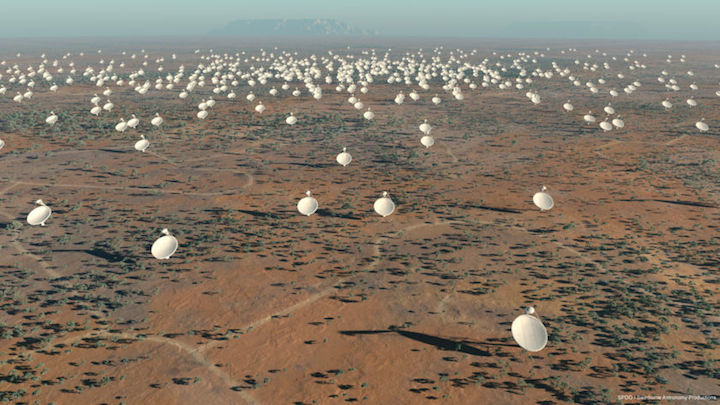
SKA Organisation
SQUARE KILOMETRE ARRAY
An artist’s concept of a portion of the Square Kilometre Array, in South Africa.MeerKAT picks up mid-frequency radio waves, including the part of the spectrum traditionally targeted by SETI searches. As part of its commissioning phase, MeerKAT will conduct sky surveys, mapping the structure of the galaxy while hunting for pulsars and FRBs. Pete Worden said Breakthrough Listen is "deep in discussions" with the MeerKAT team, hoping to run piggyback SETI searches at the same time.
"These are next-generation facilities in terms of their sensitivities, and their field of view, and also in terms of the way that we can access them digitally," said Andrew Siemion. "So it's incredibly easy for us to plug instrumentation into them, and that makes it possible for us to use them for SETI very easily."
MWA is a low-frequency array. Low frequencies are not typically targeted by SETI searches because longer wavelengths constrain how much information can be transmitted over any given period of time.
Low-frequency arrays can, however, cover the entire sky all at once. For this reason, scientists like Dan Werthimer are increasingly interested in conducting SETI searches with arrays like MWA, "not necessarily because we think E.T. might be broadcasting there," but because the experience could be used to build higher-wavelength all-sky arrays like Horowitz envisioned.
"The microwave part of the spectrum that most people think about for SETI experiments—that will be a little harder," said Werthimer.
The second phase of the Square Kilometer Array, SKA-2, includes a mid-frequency array called MFAA. One of its proposed precursors, MANTIS, would use 250,000 antennas to cover 200 square degrees of sky at once—the equivalent of 1,000 Moons. Its frequency range is 450 to 1,450 megahertz—a large chunk of the water hole, making it a good tool for SETI research.
Though the U.S. did not help fund SKA, the National Radio Astronomy Observatory is considering its own ambitious, SKA-like facility called the next-generation Very Large Array, or ngVLA. Should it be built, the ngVLA would consist of 214, 28-meter high-frequency radio dishes in the southwestern U.S. capable of receiving signals from 1,200 megahertz to 116 gigahertz. Jill Tarter said SETI researchers are making the case that the search for life should be part of the ngVLA's science justification, should it be built.
Big data
In an era where the term "big data" dominates the technology landscape, many SETI scientists are eyeing improvements to the way telescope signals are stored and processed.
At Parkes, Breakthrough stores up to 100 times more data than a typical telescope user—down to individual voltage levels bouncing off the dish itself. The team currently stores a petabyte, or 1,000 terabytes, of those data. "But they quickly get through that," said Jimi Green, the Parkes scientist.
New algorithms and machine learning could help rule out spurious signals while finding hidden ones scientists don't know to look for. Pete Worden hopes to bring in help, perhaps on a volunteer basis, from unique places like the intelligence community.
"We'd really kind of like to get somebody that may work in the daytime for a three-letter agency, who goes home at night, downloads the data says 'Hey, I found something interesting,'" Worden said.
About a year ago, the SETI Institute teamed up with IBM to start using machine learning to sift through the 54 terabytes of data per day the Allen Array captures. Bill Diamond said IBM was interested in placing the data in "a gymnasium for software" to test new computing algorithms. In return, the SETI Institute gets access to cloud computing resources and tools.
"It's almost like building a new instrument, or building a new telescope," Diamond said.
The big picture
During his 1978 Tonight Show appearance, Carl Sagan theorized about what it might mean to establish two-way communication with another civilization.
"We are at a very dangerous moment in human history," he said. "We have weapons of mass destruction, we are in the process of inadvertently altering our climate—exhaustion of fossil fuels and minerals—all kinds of problems that come with technology. We are not certain that we will be able to survive this period of what I like to call technological adolescence. Were we to receive a message from somewhere else, it would show that it's possible to survive this kind of period. And that's a useful bit of information to have."
Humans have only had radio technology for a century—just a blip on the galactic timescale. If we do find intelligent beings, it would be "awfully unusual to find them where they just discovered radio a hundred years ago," Werthimer said. Odds are they'll be much more advanced than us, and potentially able to offer the kind of guidance Sagan envisioned.
Hearing nothing won't necessarily mean no one is out there; perhaps we aren't looking the right way. What if intelligent beings communicate using a form of energy stronger than gamma rays? Or chat via subspace, like on Star Trek?
"We have to reserve the right to get smarter," Tarter said. "We may be doing a fantastic, excellent job at just the wrong thing."
Or, we could truly be alone in the cosmos. Paraphrasing Arthur C. Clarke, Siemion said the non-detection of intelligent life would be just as profound as detecting it.
"The only thing weirder than there being intelligent life out there is that there is not intelligent life out there," he said. "These ideas are kind of equally compelling—equally strange and amazing."
At a Breakthrough Initiatives meeting just before the Listen project was announced, each team member predicted the odds the effort would find intelligent life, Worden said.
"The numbers ranged from a percent or two, to ten to the minus fifth," he said. Milner was among the low end of the estimates.
"I was just thinking at the time, if I had gone to the U.S. government and said I want a hundred million bucks to do something, and they asked me what I thought the probability of success was, even if I had said two percent, they would have said, 'you must be nuts,'" he said.
Even negative results help define the boundaries of where and how to look. And the only way to know for sure whether there's anybody out there is to keep searching.
"I think most people in the public think we're always looking, which is totally not true," said Shelley Wright. "We've barely looked, contrary to all of our sci-fi movies."
Quelle: The Planetary Society
